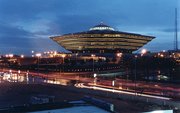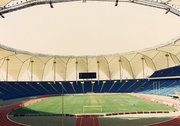Riyadh
|
|
Pl1_42.jpg
Mamlakka.JPG
Riyadh (Template:Lang-ar ar-Riyāḍ) is the capital of the kingdom of Saudi Arabia, located in the Najd region. It is situated in the centre of the Arabian peninsula on a large plateau and is home to over 3,500,000 people (14% of the nation's population). Riyadh covers more than 600 square miles (1,554 km²).
The city lies in Saudi Arabia's 'central corridor' of development along with Buraydah and Al Kharj in the Ar Riyad administrative division. The other areas of concentrated population are two coastal areas - around Jiddah and Mecca on the Red Sea, and around Jubail and Dhahran on the Persian Gulf. Riyadh is located at 24°42'42" North, 46°43'27" East (24.711667, 46.724167). [1] (http://earth-info.nga.mil/gns/html/cntry_files.html)
The city is divided into 17 branch municipalities under the control of the Riyadh Municipality and the Riyadh Development Authority, chaired by Riyadh Province Governor Prince Salman Bin Abdul Aziz.
Although in a highly arid area the city does receive some rainfall. Five dams store the runoff. There are also 96 wells and 290 miles (467 km) of pipe bringing huge volumes of water from desalination plants on the Persian Gulf.
History
In pre-Islamic times, the settlement at the site was called Hajar. The site is at the confluence of several rivers (now wadis) and much underground water is accessible at the site. The settlement was historically famous for its dates and orchards. Its name derives from the plural of the Arabic rowdhah (place of gardens). The modern name was first applied to only certain parts of the settlement where orchards predominated. Gradually the name was used for the entire settlement.
By the end of the 18th century, Riyadh was part of the First Saudi State, with the capital at Diriyah. After the destruction of Diriyah in 1818 by the Turks, the capital moved to Riyadh. Portions of Diriyah, a city made of mud bricks, still exisits.
The city was seized in 1902 by Abdul Aziz bin Abdul Rahman Al Saud. He went on to established the modern Kingdom of Saudi Arabia in 1932, with Riyadh the capital of the nation. The diplomatic capital did not move until 1982 (from Jeddah). Recently the city has experienced very high rates of population growth, which is indicated by the poor quality of development since the 1970s.
Buildings
Population
- 1862 - 7,500
- 1935 - 30,000
- 1960 - 150,000
- 1970 - 370,000
- 1972 - 500,000
- 1974 - 650,000
- 1988 - 1,500,000
- 1990 - 2,000,000
- 1997 - 2,800,000
- 2007 - 6,000,000*
- 2020 - 9,900,000*
* denotes estimates
Between 1974 and 1992 the city grew by an average of 8.2% per year.
Noted structures in the city include Al Faisaliah and Al Mamlaka/Kingdom Centre (the two tallest structures in Saudi Arabia at 267m and 302m respectively), King Khalid Airport, King Fahd Stadium, Al Masmak Palace, Sahah Al Hukom and Qasr-al-Hukm. Major areas include Olaya, in downtown, Dabab, near the Old Airport (King Fahd Airbase) and Batha, the old downtown part of the city.ar:الرياض ca:Al-Riyad da:Riyadh de:Riad es:Riad id:Riyadh he:ריאד nl:Riyad ja:リヤド pl:Rijad pt:Riade sk:Rijád fi:Riad zh:利雅德



